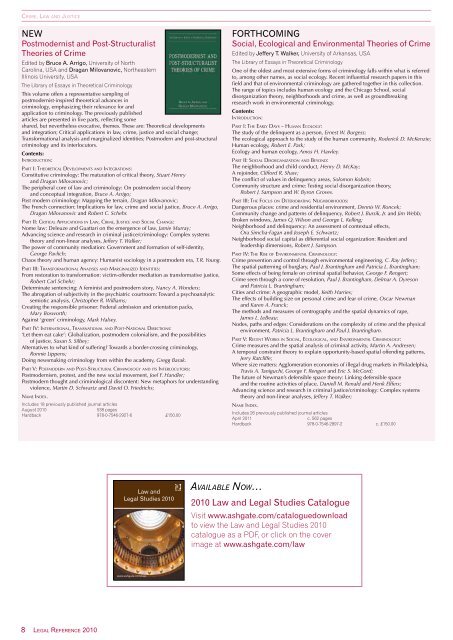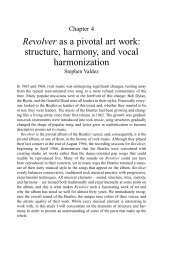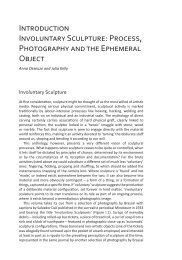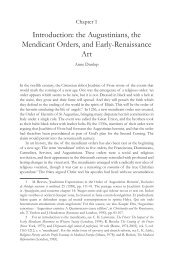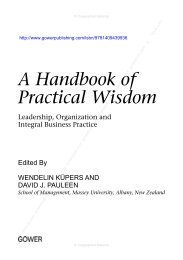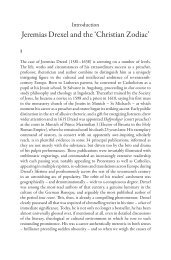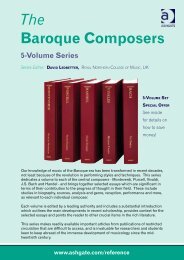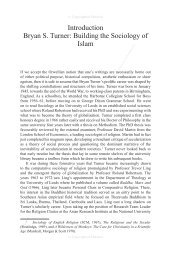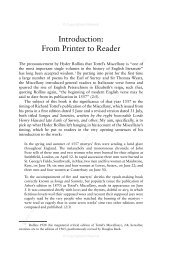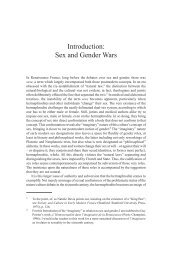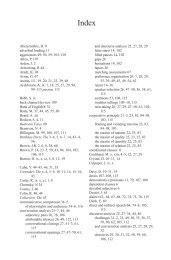facebook - Ashgate
facebook - Ashgate
facebook - Ashgate
You also want an ePaper? Increase the reach of your titles
YUMPU automatically turns print PDFs into web optimized ePapers that Google loves.
CRIME, LAW AND JUSTICE<br />
NEW<br />
Postmodernist and Post-Structuralist<br />
Theories of Crime<br />
Edited by Bruce A. Arrigo, University of North<br />
Carolina, USA and Dragan Milovanovic, Northeastern<br />
Illinois University, USA<br />
The Library of Essays in Theoretical Criminology<br />
This volume offers a representative sampling of<br />
postmodernist-inspired theoretical advances in<br />
criminology, emphasizing their relevance for and<br />
application to criminology. The previously published<br />
articles are presented in five parts, reflecting some<br />
shared, but nevertheless evocative, themes. These are: Theoretical developments<br />
and integration; Critical applications in law, crime, justice and social change;<br />
Transformational analysis and marginalized identities; Postmodern and post-structural<br />
criminology and its interlocutors.<br />
Contents:<br />
INTRODUCTION:<br />
PART I: THEORETICAL DEVELOPMENTS AND INTEGRATIONS:<br />
Constitutive criminology: The maturation of critical theory, Stuart Henry<br />
and Dragan Milovanovic;<br />
The peripheral core of law and criminology: On postmodern social theory<br />
and conceptual integration, Bruce A. Arrigo;<br />
Post modern criminology: Mapping the terrain, Dragan Milovanovic;<br />
The French connection: Implications for law, crime and social justice, Bruce A. Arrigo,<br />
Dragan Milovanovic and Robert C. Schehr.<br />
PART II: CRITICAL APPLICATIONS IN LAW, CRIME, JUSTICE AND SOCIAL CHANGE:<br />
Nome law: Deleuze and Guattari on the emergence of law, Jamie Murray;<br />
Advancing science and research in criminal justice/criminology: Complex systems<br />
theory and non-linear analyses, Jeffery T. Walker;<br />
The power of community mediation: Government and formation of self-identity,<br />
George Pavlich;<br />
Chaos theory and human agency: Humanist sociology in a postmodern era, T.R. Young.<br />
PART III: TRANSFORMATIONAL ANALYSES AND MARGINALIZED IDENTITIES:<br />
From restoration to transformation: victim-offender mediation as transformative justice,<br />
Robert Carl Schehr;<br />
Determinate sentencing: A feminist and postmodern story, Nancy A. Wonders;<br />
The abrogation of subjectivity in the psychiatric courtroom: Toward a psychoanalytic<br />
semiotic analysis, Christopher R. Williams;<br />
Creating the responsible prisoner: Federal admission and orientation packs,<br />
Mary Bosworth;<br />
Against ‘green’ criminology, Mark Halsey.<br />
PART IV: INTERNATIONAL,TRANSNATIONAL AND POST-NATIONAL DIRECTIONS:<br />
‘Let them eat cake’: Globalization, postmodern colonialism, and the possibilities<br />
of justice, Susan S. Silbey;<br />
Alternatives to what kind of suffering? Towards a border-crossing criminology,<br />
Ronnie Lippens;<br />
Doing newsmaking criminology from within the academy, Gregg Barak.<br />
PART V: POSTMODERN AND POST-STRUCTURAL CRIMINOLOGY AND ITS INTERLOCUTORS:<br />
Postmodernism, protest, and the new social movement, Joel F. Handler;<br />
Postmodern thought and criminological discontent: New metaphors for understanding<br />
violence, Martin D. Schwartz and David O. Friedrichs;<br />
NAME INDEX.<br />
Includes 18 previously published journal articles<br />
August 2010 538 pages<br />
Hardback 978-0-7546-2927-6 £150.00<br />
8 LEGAL REFERENCE 2010<br />
Law and<br />
Legal Studies 2010<br />
www.ashgate.com/law<br />
FORTHCOMING<br />
Social, Ecological and Environmental Theories of Crime<br />
Edited by Jeffery T. Walker, University of Arkansas, USA<br />
The Library of Essays in Theoretical Criminology<br />
One of the oldest and most extensive forms of criminology falls within what is referred<br />
to, among other names, as social ecology. Recent influential research papers in this<br />
field and that of environmental criminology are gathered together in this collection.<br />
The range of topics includes human ecology and the Chicago School, social<br />
disorganization theory, neighborhoods and crime, as well as groundbreaking<br />
research work in environmental criminology.<br />
Contents:<br />
INTRODUCTION:<br />
AVAILABLE NOW…<br />
PART I: THE EARLY DAYS – HUMAN ECOLOGY:<br />
The study of the delinquent as a person, Ernest W. Burgess;<br />
The ecological approach to the study of the human community, Roderick D. McKenzie;<br />
Human ecology, Robert E. Park;<br />
Ecology and human ecology, Amos H. Hawley.<br />
PART II: SOCIAL DISORGANIZATION AND BEYOND:<br />
The neighborhood and child conduct, Henry D. McKay;<br />
A rejoinder, Clifford R. Shaw;<br />
The conflict of values in delinquency areas, Solomon Kobrin;<br />
Community structure and crime: Testing social disorganization theory,<br />
Robert J. Sampson and W. Byron Groves.<br />
PART III: THE FOCUS ON DETERIORATING NEIGHBORHOODS:<br />
Dangerous places: crime and residential environment, Dennis W. Roncek;<br />
Community change and patterns of delinquency, Robert J. Bursik, Jr. and Jim Webb;<br />
Broken windows, James Q. Wilson and George L. Kelling;<br />
Neighborhood and delinquency: An assessment of contextual effects,<br />
Ora Simcha-Fagan and Joseph E. Schwartz;<br />
Neighborhood social capital as differential social organization: Resident and<br />
leadership dimensions, Robert J. Sampson.<br />
PART IV: THE RISE OF ENVIRONMENTAL CRIMINOLOGY:<br />
Crime prevention and control through environmental engineering, C. Ray Jeffery;<br />
The spatial patterning of burglary, Paul J. Brantingham and Patricia L. Brantingham;<br />
Some effects of being female on criminal spatial behavior, George F. Rengert;<br />
Crime seen through a cone of resolution, Paul J. Brantingham, Delmar A. Dyreson<br />
and Patricia L. Brantingham;<br />
Cities and crime: A geographic model, Keith Harries;<br />
The effects of building size on personal crime and fear of crime, Oscar Newman<br />
and Karen A. Franck;<br />
The methods and measures of centrography and the spatial dynamics of rape,<br />
James L. LeBeau;<br />
Nodes, paths and edges: Considerations on the complexity of crime and the physical<br />
environment, Patricia L. Brantingham and Paul J. Brantingham.<br />
PART V: RECENT WORKS IN SOCIAL, ECOLOGICAL, AND ENVIRONMENTAL CRIMINOLOGY:<br />
Crime measures and the spatial analysis of criminal activity, Martin A. Andresen;<br />
A temporal constraint theory to explain opportunity-based spatial offending patterns,<br />
Jerry Ratcliffe;<br />
Where size matters: Agglomeration economies of illegal drug markets in Philadelphia,<br />
Travis A. Taniguchi, George F. Rengert and Eric S. McCord;<br />
The future of Newman’s defensible space theory: Linking defensible space<br />
and the routine activities of place, Daniell M. Renald and Henk Elffers;<br />
Advancing science and research in criminal justice/criminology: Complex systems<br />
theory and non-linear analyses, Jeffery T. Walker;<br />
NAME INDEX.<br />
Includes 26 previously published journal articles<br />
April 2011 c. 562 pages<br />
Hardback 978-0-7546-2897-2 c. £150.00<br />
2010 Law and Legal Studies Catalogue<br />
Visit www.ashgate.com/cataloguedownload<br />
to view the Law and Legal Studies 2010<br />
catalogue as a PDF, or click on the cover<br />
image at www.ashgate.com/law


